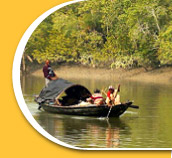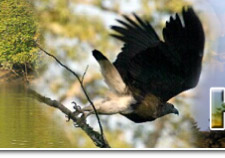Kaziranga to Kanha : The best of Indian Wildlife
 Kaziranga National Park is renowned as one of the finest and most picturesque wildlife refuges in southern Asia. It protects the world's largest Indian rhinoceros population, as well as many other threatened species. It is situated in Nowgaon and Golaghat districts on the southern bank of the Brahmaputra River at the foot of the Mikir Hills, some 8km from Bokakhat. National Highway No. 37 forms the southern boundary. It was notified as a national park on 11 February 1974. Originally established as a reserved forest in 1908, a game sanctuary in 1916 and a wildlife sanctuary in 1950. Inscribed on the World Heritage List in 1985. It covers an area of 42,996ha, of which some 5,000ha has been lost due to erosion of the northern boundary by the Brahmaputra River. According to official records, the actual land area is 37,822ha. An addition of some 45,450ha is proposed and includes the Brahmaputra River to the north and part of the Mikir Hills to the south. The altitude ranges between 40m and 80m. To the south of the park, the Mikir Hills rise to about 1,220m. Kaziranga National Park is renowned as one of the finest and most picturesque wildlife refuges in southern Asia. It protects the world's largest Indian rhinoceros population, as well as many other threatened species. It is situated in Nowgaon and Golaghat districts on the southern bank of the Brahmaputra River at the foot of the Mikir Hills, some 8km from Bokakhat. National Highway No. 37 forms the southern boundary. It was notified as a national park on 11 February 1974. Originally established as a reserved forest in 1908, a game sanctuary in 1916 and a wildlife sanctuary in 1950. Inscribed on the World Heritage List in 1985. It covers an area of 42,996ha, of which some 5,000ha has been lost due to erosion of the northern boundary by the Brahmaputra River. According to official records, the actual land area is 37,822ha. An addition of some 45,450ha is proposed and includes the Brahmaputra River to the north and part of the Mikir Hills to the south. The altitude ranges between 40m and 80m. To the south of the park, the Mikir Hills rise to about 1,220m.
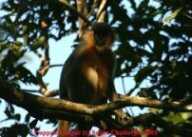 The park lies in the flood plains of the Brahmaputra River. The riverine habitat consists primarily of tall, dense grasslands interspersed with open forests, interconnecting streams and numerous small lakes or 'bheels'. Three-quarters or more of the area is submerged annually by the floodwaters of the Brahmaputra. Soils are alluvial deposits of the Brahmaputra and its tributaries. At the Park three seasons can be distinguished. Summer, which is dry and windy, extends from mid-February to May with mean maximum and minimum temperatures of 37°C and 7°C, respectively. The monsoon occurs from May to September when conditions are warm and humid. Most of the mean annual rainfall of 2220mm falls during this season. During winter (November to mid-February), when conditions are mild and dry, mean maximum and minimum temperatures are 25°C and 5°C, respectively. The park lies in the flood plains of the Brahmaputra River. The riverine habitat consists primarily of tall, dense grasslands interspersed with open forests, interconnecting streams and numerous small lakes or 'bheels'. Three-quarters or more of the area is submerged annually by the floodwaters of the Brahmaputra. Soils are alluvial deposits of the Brahmaputra and its tributaries. At the Park three seasons can be distinguished. Summer, which is dry and windy, extends from mid-February to May with mean maximum and minimum temperatures of 37°C and 7°C, respectively. The monsoon occurs from May to September when conditions are warm and humid. Most of the mean annual rainfall of 2220mm falls during this season. During winter (November to mid-February), when conditions are mild and dry, mean maximum and minimum temperatures are 25°C and 5°C, respectively.
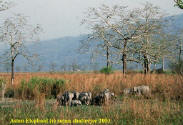 Here there are three main types of vegetation: alluvial inundated grasslands, tropical wet evergreen forests and tropical semi-evergreen forests. Grasslands predominate in the west, with tall 'elephant' grasses on the higher ground and short grasses on the lower ground surrounding the water bodies or 'bheels'. Annual flooding and burning over thousands of years have maintained them. Here there are three main types of vegetation: alluvial inundated grasslands, tropical wet evergreen forests and tropical semi-evergreen forests. Grasslands predominate in the west, with tall 'elephant' grasses on the higher ground and short grasses on the lower ground surrounding the water bodies or 'bheels'. Annual flooding and burning over thousands of years have maintained them.
The park contains about 15 species of India's threatened (Schedule I) mammals. It harbours the world's largest population of Indian One-horned Rhinoceros Rhinoceros unicornis, which has increased from a few dozen in 1908 to a more recent number of 1,500 in 2002. Asian Elephant Elephas maximus are thought to number 1,100.
Other mammals include Capped Langur, a small population of Hoolock Gibbon, Indian Tiger, Leopard, Sloth Bear, Ganges Dolphin, Otter, Wild Boar, Asiatic Water Buffalo, Swamp Deer or Barasingha, Hog Deer and Indian Muntjac. The numerous water bodies are rich reservoirs of food (including fish) and thousands  of migratory birds, representing over 100 species, visit the park seasonally from as far a field as Western Europe. There is a Grey Pelican rookery near Kaziranga Village. Other birds of interest include Black-Necked Stork, Lesser Adjutant, Pallas's Fish Eagle, Grey-Headed Fish Eagle, perhaps Bengal Florican, Swamp Francolin, Kalij Pheasant, Great Pied Hornbill, Emerald Dove and Jerdon's bushchat. The avifauna comprises over 478 species. of migratory birds, representing over 100 species, visit the park seasonally from as far a field as Western Europe. There is a Grey Pelican rookery near Kaziranga Village. Other birds of interest include Black-Necked Stork, Lesser Adjutant, Pallas's Fish Eagle, Grey-Headed Fish Eagle, perhaps Bengal Florican, Swamp Francolin, Kalij Pheasant, Great Pied Hornbill, Emerald Dove and Jerdon's bushchat. The avifauna comprises over 478 species.
Kanha Tiger Reserve was one of the first 9 Project Tiger areas initiated in the year 1973, it is nestled in the ranges of the Satpuras in Madhya Pradesh and abounding in Sal and mixed forests. The total area covers 1945 sq. kms with a core area of 940 sq. kms. The area was enlarged after Project Tiger was initiated and still awaits final legal notification. The tiger population was said to be 48 in 1976 and is estimated today more than 100.
Famously the ‘jungle’ that inspired Rudyard Kipling’s Jungle Book, the Kanha Tiger Reserve is not at all as depicted in the Disney Cartoon – all steaming jungle and thick undergrowth. Having said this, all the animals of the cartoon – with the exception of the elephant - do reside there. It is a beautiful area, comprising sal and bamboo forest, grasslands and river habitat. The most prevalent animal is the Chital (or spotted deer) which can be viewed grazing peacefully on meadows or amongst trees, often near langur monkeys, who not only dislodge fruit and seeds from the trees which the chital then eat, but who also provide a look out for tiger. It contains the world's only population of the Hard Ground barasingha deer (a different subspecies Swamp Deer), and the reserve's authorities have been instrumental in rescuing the species from imminent extinction. The management input into Kanha Tiger Reserve of the Central Indian highlands, from where the reverberating call of the tiger and the braying of the mating hard ground Barasingha resounds has probably achieved quite spectacular results during the past three decades. Reserve is not at all as depicted in the Disney Cartoon – all steaming jungle and thick undergrowth. Having said this, all the animals of the cartoon – with the exception of the elephant - do reside there. It is a beautiful area, comprising sal and bamboo forest, grasslands and river habitat. The most prevalent animal is the Chital (or spotted deer) which can be viewed grazing peacefully on meadows or amongst trees, often near langur monkeys, who not only dislodge fruit and seeds from the trees which the chital then eat, but who also provide a look out for tiger. It contains the world's only population of the Hard Ground barasingha deer (a different subspecies Swamp Deer), and the reserve's authorities have been instrumental in rescuing the species from imminent extinction. The management input into Kanha Tiger Reserve of the Central Indian highlands, from where the reverberating call of the tiger and the braying of the mating hard ground Barasingha resounds has probably achieved quite spectacular results during the past three decades.
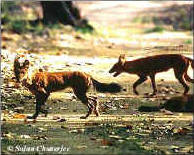 Through intensive protection of the natural habitat and the resident mute denizens and also by complete elimination of the biotic influences in Kanha, it was possible to retrieve the ecological loss that had been sustained earlier. Kanha once again looked probably like what Forsythe, Brander and Kipling had observed decades back. The Barasingha population climbed back once left to nature. Through intensive protection of the natural habitat and the resident mute denizens and also by complete elimination of the biotic influences in Kanha, it was possible to retrieve the ecological loss that had been sustained earlier. Kanha once again looked probably like what Forsythe, Brander and Kipling had observed decades back. The Barasingha population climbed back once left to nature.
This is the only Tiger Reserve, where some substantial ecological research had been carried out, under the able hands of a keen researcher, who had been aptly supported by the Field Director. Kanha Tiger Reserve is the true flagship of Project Tiger in terms of management, research and the effective control of problems.
The tiger is probably the animal above all others that people come to India to view, and at Kanha you stand as 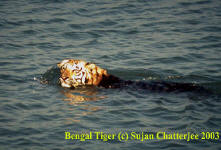 good a chance as anywhere of seeing one. There are also leopard at Kanha too, but though probably more numerous than the tiger, they are more difficult to spot. On any trip you will undoubtedly see chital, gaur (the enormous Indian wild bovid - which can stand six feet at the shoulder), Sambar (India's largest deer), Indian Wild Dog or Dhole, Wild Boar, Jackal, Barasingha, Jungle Cat, Peacocks in abundance, and numerous species of bird. As much as anything, what will captivated you most about Kanha, aside from the tiger, is the sound of the jungle. There is a steady hum of insect noise and birdsong wherever you go. Furthermore, when there is a tiger or leopard on the move you will hear a cacophony of alarm calls made by a variety of animals and birds (from langur monkey to peacock), and it is these – together with pug marks on the dusty track - which enables the skilled trackers to locate the tigers. good a chance as anywhere of seeing one. There are also leopard at Kanha too, but though probably more numerous than the tiger, they are more difficult to spot. On any trip you will undoubtedly see chital, gaur (the enormous Indian wild bovid - which can stand six feet at the shoulder), Sambar (India's largest deer), Indian Wild Dog or Dhole, Wild Boar, Jackal, Barasingha, Jungle Cat, Peacocks in abundance, and numerous species of bird. As much as anything, what will captivated you most about Kanha, aside from the tiger, is the sound of the jungle. There is a steady hum of insect noise and birdsong wherever you go. Furthermore, when there is a tiger or leopard on the move you will hear a cacophony of alarm calls made by a variety of animals and birds (from langur monkey to peacock), and it is these – together with pug marks on the dusty track - which enables the skilled trackers to locate the tigers.
The climate of this region is tropical. Summers are hot and humid with a maximum and minimum temperature of 40.6°C and 23.9°C. Winters are pleasant with an average maximum and minimum temperature of 22°C and 6°C, respectively. The early morning wind chill can go below -2°C. The annual average rainfall is 152 cm. The park is closed from July to mid-November during monsoon.
 Wildlife tourism is not as developed in India as it is in Africa, and this is reflected in the quality of the accommodation, which is basic. However if you are here solely for the wildlife then this will be an irrelevance. Also, the area of the park is much smaller than say that of the most African parks, and the number of tigers there is far less than the number of lions in most major East African reserves. However there is something so compelling about the tiger that even if you are one of ten vehicles all following one tiger as it goes about its business, you will probably be able to blank out everything else as you marvel at the sheer power, grace and majesty of this incredible animal. Likewise, though you will not see anything like the volume of wildlife in Indian reserves as you will in African ones, a single sighting of a tiger in the wild has as much power to excite as seeing plains teeming with thousands of wildebeest. Wildlife tourism is not as developed in India as it is in Africa, and this is reflected in the quality of the accommodation, which is basic. However if you are here solely for the wildlife then this will be an irrelevance. Also, the area of the park is much smaller than say that of the most African parks, and the number of tigers there is far less than the number of lions in most major East African reserves. However there is something so compelling about the tiger that even if you are one of ten vehicles all following one tiger as it goes about its business, you will probably be able to blank out everything else as you marvel at the sheer power, grace and majesty of this incredible animal. Likewise, though you will not see anything like the volume of wildlife in Indian reserves as you will in African ones, a single sighting of a tiger in the wild has as much power to excite as seeing plains teeming with thousands of wildebeest.
<< Wildlife Tours in India | Sundarban Jungle Camp | Top | Wildlife Natural History Tours in India >> |
